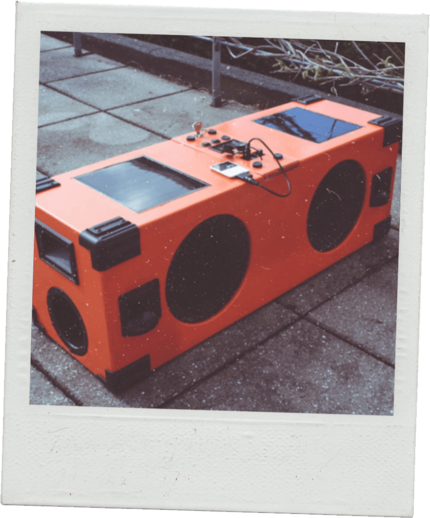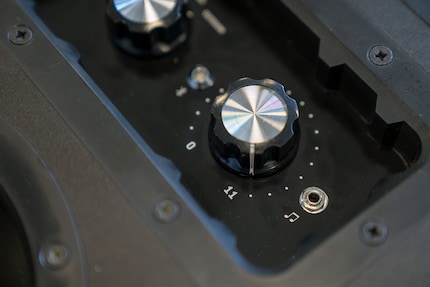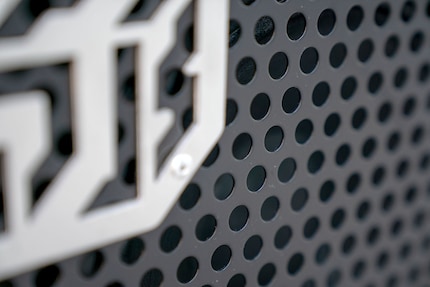

Soundboks 2: How to make the big noise even louder
Soundboks promises to make the most noise that can be achieved with a portable speaker. A test between boathouse and late puberty prollen.
"The Loudest Battery-Powered Speaker."
The advertising slogan of the Soundboks company makes me sit up and take notice. Because I have a somewhat strange relationship with battery-powered speakers. On the one hand, I hate them with a passion. Because if you have to have some shitty sound playing all the time at Letten or Chinawiese so that the whole neighbourhood can hear how shitty your taste in music is, complete with the sentence "Bro, check out this track" after half a song has played... Good man, then you're an asshole. Dear lady, so are you. And your Bluetooth speaker is an expression of that. Nobody likes you. Nobody likes your sound. And if I see you on the way out, I'll spit in your drink. Asshole.
On the other hand, I think the speakers are great. How much technology and power have clever engineers packed into the box? How much work and intelligence has gone into a box like that? I look with admiration at the people who have managed to make the noise beautiful and portable. After all, who doesn't like good sound? Rich bass and ringing highs are simply something beautiful.

While I'm trying to explain this almost Orwellian doublethink to my manager, the Soundboks is standing in front of me. My fingers are itching. I want to make noise. Big noise.
Who or what is a Soundboks?
But let's start at the beginning, as beginnings tend to do. In 2007, a man who went down in the annals of Soundboks history as "Saturnus" built a loudspeaker that made its main appearance at the Roskilde Festival in Roskilde, Denmark - where else? - had its main appearance. The thing was powered by a car battery, weighed 25 kilos, was hideous, but loud.

Source: soundboks.com
The butt-ugly speaker with noise became a business idea. The three men named Jesper, Christoffer and Hjalte have since stylised themselves as "party professionals" and make loudspeakers. But the three are not satisfied with just any loudspeakers. Their speakers have to fulfil the following criteria:
- They have to be extremely loud
- They have to be portable and the battery has to last forever
- They must be completely safe from drunks
The three have given up their university plans and set to work. They sold an initial batch of 400 boxes at the Roskilde Festival, then launched a Kickstarter campaign. The Danes wanted 100,000 dollars and received 784,320 dollars
And then one of the speakers ends up in my office. Time to make some noise.
Moment, it's not that loud
In the afternoon, I carry the 15-kilo box onto the driveway to our office building. The smokers are standing outside, shortening their lives one breath at a time. They drink coffee, chat and are generally at peace.
I can remedy this, because somehow I think that AC/DC's "Thunderstruck" is the perfect background music for such a peaceful get-together.
The Soundboks is set up quickly: cable plugged into the wall as the battery is empty - I assume that someone has already tested the thing extensively before me - and then connected to my mobile via Bluetooth.
The song begins. As a precaution, I set the volume of the speaker to level 5. For the first time, however, the Soundboks make me laugh. The three Danes were inspired by the 1984 film "This is Spinal Tap". The volume control goes up to 11, not 10.

In the film scene, the fictional rocker Nigel Tufnel (Christopher Guest) explains to a journalist that his amplifier goes up to 11. It is therefore "one louder" than ordinary amplifiers. When asked whether it wouldn't have been more sensible to simply make 10 a little louder, Tufnel says "These go up to eleven" after a brief pause for thought, making film and music history.
Eleven. I like that. I'm turning it up.
The Soundboks is loud. But not "extremely loud". Good, then we'll just turn up the volume of the Bluetooth output on the mobile. Because if you want real noise, you don't just have to turn up the volume on the speaker, but also on the mobile phone.
It gets loud for a moment, then quiet.
More juice!
No matter how many times I repeat the experiment, the result remains the same. I turn up the volume, AC/DC goes silent. In the meantime, a few smokers have gathered around the speaker. We enjoy the music, music requests follow.
But every time I turn up the volume on my mobile, the Soundboks stops working because the Bluetooth stream from the smartphone to the speaker is running. This calls engineer René Zweifel onto the scene. The bearded man looks at the speaker, twists the mains adapter and checks the power supply unit.
"Forget about that. It's not going to work," he says.

Because, as René explains, the power supply unit provided does not supply enough power to cover the speaker's requirements at maximum volume. The result: silence. Quiet is not good if you want noise. In fact, quiet is the exact opposite of what you want.
"I'll fix that," René mumbles into his beard and walks into the office building.
While the concert of wishes continues outside, René looks for his "second power supply unit", as he calls it, and comes back with it. Because Soundboks knows that the products they supply can't keep up. That's why the rear part of the plug that goes into the speaker is fitted with a female adapter. In short, this means you can add power with a mains adapter.
"Thunderstruck" again.
At volume 11.
A grin spreads across the small group around René and I.
Is this the loudest box ever? Quite possibly. Is the sound good? Yes, even at 119 decibels. On the engineering side, you can't fault the people at Soundboks.
At the boathouse rave
Since hardly anyone can ignore the speaker, graphic designer Julian Stauffer becomes aware of the speaker. He wanted to borrow it for a rave in a boathouse. He wrote the following lines:
"When I saw this huge thing, the Soundboks 2, at Dominik's place, I suddenly had the idea for a test. I asked him if I could borrow the speakers because my wife wanted to celebrate herself for a weekend at a boathouse on Lake Zurich. She was just over 30 years old and we didn't yet have a sound system for the party. Small UE Boom speakers wouldn't have been enough for 35 or more guests, and two EX10s from KV2 Audio would have been too much."
I'm also doing the test in the hope that I can draw the attention of the sea police to us. After all, the boxes promise quite a performance.
What surprised me most was the weight of the Soundboks; despite the size, the system is surprisingly easy to transport. At the same time, I also thought to myself, something so light can't perform well.
I'll make a long story short: the sea police didn't turn up. Unfortunately. Not that the speaker can't be loud - yes, yes, it can - but at a certain volume, the treble starts to get noisy. It tears up the upper range to such an extent that it was simply unbearable for me. The other attendees were less bothered by it, either they've all spent half their lives in bad clubs, have bad hearing or they don't mind that the music just sounds like shit.
As a comparison: Someone else also took a speaker with them, a Bose speaker that is no longer available in stores. This speaker ran at a lower volume, but had much more bass and filled the semi-open room wonderfully.
In short: The Soundboks 2 is sufficient for late-pubertal prollen, but if you have a little reverence for your ears and can't stand it when well-produced music sounds like shit, don't buy the speaker.
Journalist. Author. Hacker. A storyteller searching for boundaries, secrets and taboos – putting the world to paper. Not because I can but because I can’t not.